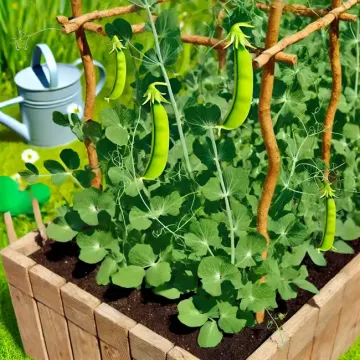History of Green Peas
Peas have been cultivated for thousands of years, with their origins tracing back to the Middle East. They were an essential crop in ancient civilizations such as Egypt, Greece, and Rome. Initially, peas were dried and used as a staple food. However, during the Middle Ages, fresh peas became a delicacy in Europe, particularly in France and England. Today, green peas are enjoyed worldwide and remain a popular crop for home gardeners.
Health Benefits
Green peas are not just delicious; they are also packed with nutrients. They are a great source of plant-based protein, making them a valuable addition to vegetarian and vegan diets. Peas are rich in fiber, vitamins A, C, and K, as well as folate and manganese. Their high fiber content promotes digestive health, while the antioxidants found in peas support overall wellness and may reduce inflammation.
Types of Green Peas
There are three main types of green peas:
- Shelling Peas (English Peas): These peas are grown for their seeds, which are removed from the inedible pods before eating. They are typically used in cooking or eaten fresh.
- Snow Peas: Snow peas have flat, edible pods that are harvested before the peas inside mature. They are commonly used in stir-fries and salads.
- Sugar Snap Peas: Sugar snap peas have thick, crunchy, edible pods and sweet peas inside. They are a versatile variety, delicious both raw and cooked.
Planting Green Peas
Green peas are a cool-weather crop, thriving in temperatures between 55°F and 70°F (13°C to 21°C). They are often one of the first vegetables planted in the spring, as they can tolerate light frost.
When to Plant: Peas should be planted as soon as the soil can be worked in early spring, typically 4 to 6 weeks before the last expected frost date. In regions with a mild fall, peas can also be planted for a fall harvest.
Location: Choose a sunny spot with well-drained soil. Peas prefer slightly acidic to neutral soil with a pH between 6.0 and 7.0.
Soil Preparation: Peas fix nitrogen in the soil, making them an excellent crop for improving soil fertility. However, they still benefit from starting in nutrient-rich soil. Add compost or well-rotted manure to the planting area before sowing seeds.
Planting Depth and Spacing: Sow pea seeds 1 inch deep and 2 inches apart. Space rows about 18 to 24 inches apart. For climbing varieties, ensure you provide a trellis, fence, or netting to support the vines.
Care and Maintenance
Green peas require regular care to ensure a bountiful harvest. Here are some tips for their successful cultivation:
- Watering: Keep the soil consistently moist but not waterlogged. Water peas at the base to avoid wetting the foliage, which can lead to disease.
- Mulching: Apply a layer of mulch around the plants to retain soil moisture and suppress weeds.
- Trellising: Climbing pea varieties need support. Use stakes, wire mesh, or garden twine to create a trellis that helps the vines grow upright, which improves air circulation and ease of harvesting.
- Fertilizing: Peas do not require heavy fertilization since they can fix their own nitrogen. However, a light application of a balanced fertilizer before planting can promote healthy growth. Avoid high-nitrogen fertilizers, which can lead to excessive foliage at the expense of pod production.
Common Pests and Diseases
Peas can attract pests such as aphids, pea weevils, and cutworms. To control pests, use insecticidal soap, neem oil, or introduce beneficial insects like ladybugs and lacewings.
Peas can also be affected by fungal diseases like powdery mildew, root rot, and downy mildew. To reduce the risk of disease, avoid overhead watering, space plants properly, and rotate crops each year.
Harvesting Green Peas
Harvesting green peas depends on the type you are growing:
- Shelling Peas: Harvest when the pods are plump but still tender. The peas inside should be full-sized but not hard. To harvest, simply pull the pods off the plant.
- Snow Peas: Harvest when the pods are flat and before the peas inside develop. Snow peas are best picked when they are crisp and tender.
- Sugar Snap Peas: Harvest when the pods are full and plump but still tender. They should snap easily when bent.
Regular harvesting encourages the plants to produce more pods. Be gentle when picking peas to avoid damaging the vines.
Storing and Preserving Green Peas
Freshly harvested peas have the best flavor when eaten immediately. However, they can be stored in the refrigerator for up to a week. For longer storage, peas can be blanched and frozen. Shelling peas can also be dried for use in soups and stews.
Green peas are a fantastic addition to any home garden. With their sweet flavor, nutritional benefits, and relatively easy cultivation, peas are an excellent crop for beginners and seasoned gardeners alike. Whether you grow them for their tender pods or their sweet peas, the rewards of fresh green peas from the garden make the effort worthwhile.

